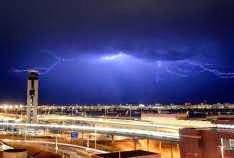Climate change may mean 50% more lightning by 2100

|
Getting your Trinity Audio player ready...
|
 Lightning has the power to spark wildfires and kill, and scientists
Lightning has the power to spark wildfires and kill, and scientists
said Thursday that climate change may lead to 50 percent more of it by
century's end.
The report in the US journal Science is based on measurements of
precipitation and cloud buoyancy, applied to 11 different climate
models that estimate how warm the planet may get by 2100.
"With warming, thunderstorms become more explosive," said climate
scientist David Romps of the University of California, Berkeley.
"Warming causes there to be more water vapor in the atmosphere, and if
you have more fuel lying around, when you get ignition, it can go big
time."
Previous estimates of how lightning would be affected used indirect
techniques that were not closely tied to precipitation.
The result was a range between five and 100 percent more lightning for
every one degree Celsius of warming.
The current study is based on the energy available to make air in the
atmosphere rise, combined with precipitation rates.
Convective available potential energy, or CAPE, is measured by
radiosondes, balloon-borne instruments released around the United
State twice daily.
"CAPE is a measure of how potentially explosive the atmosphere is,"
explained Romps.
"We hypothesized that the product of precipitation and CAPE would
predict lightning."
Using data from the US National Weather Service, researchers found
that 77 percent of variation in lightning strikes could be predicted
by knowing CAPE and precipitation.
"We were blown away by how incredibly well that worked to predict
lightning strikes," said Romps.
– More lightning –
When applying the parameters to climate models, the team found that
each one degree Celsius rise in global average air temperature would
mean about 12 percent more lightning strikes.
If temperatures warm four degrees Celsius by century's end, that would
mean nearly 50 percent more lightning by then.
Lightning now strikes 25 million times a year around the world.
More lightning strikes could place people at higher risk of being hit
and injured or killed, and may also have a devastating effect on
wildlands and species.
An uptick in the rate of strikes could cause more fires in dry
forested areas, killing off a host of birds and other woodland
creatures and endangering people who live nearby.
Lightning begins as a static charge inside a rain cloud. Turbulent
wind conditions inside the cloud can lead to a negatively charged
bottom and positively charged top.
When these electrical fields get strong enough, the atmosphere is no
longer able to insulate the electrical charge and it erupts into a
lightning strike.
"Lightning is caused by charge separation within clouds, and to
maximize charge separation, you have to loft more water vapor and
heavy ice particles into the atmosphere," said Romps.
"We already know that the faster the updrafts, the more lightning, and
the more precipitation, the more lightning."
Lightning strikes have killed 25 people in the United States so far
this year, according to the National Weather Service.
Florida had six lightning fatalities, the highest for any state.



